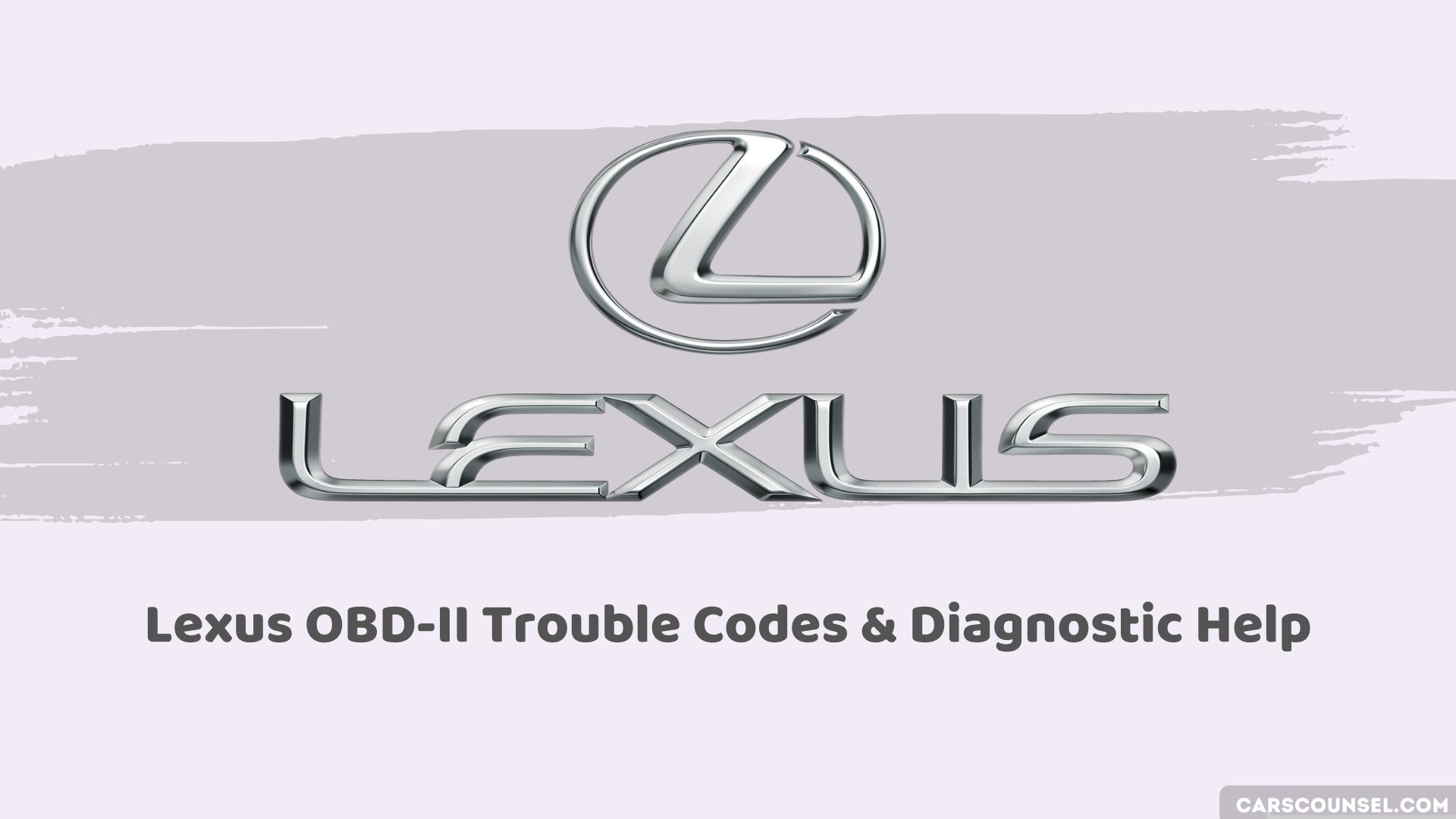As you pop the hood of your Lexus, you’re confronted with a mystery: the check engine light is on, and you’re not sure why. You’ve heard of OBD/OBD2 codes, but what do they mean, and how can they help you diagnose the issue? With hundreds of possible codes, each corresponding to a specific problem, it can be overwhelming.
But what if you knew that deciphering these codes could lead you to a quick fix, saving you time and money? You’ll want to learn more about the common error codes and solutions to get your Lexus back on the road.

Quick Navigation
Lexus OBD/OBD2 Code List
Hundreds of specific codes comprise the Lexus OBD/OBD2 code list, each corresponding to a particular issue in your vehicle.
These codes cover various systems, including engine, transmission, and emissions, providing detailed information on fault codes and vehicle systems.
You’ll find codes like P1127 ETCS Actuator Power Source Circuit Malfunction and P1128 Throttle Control Motor Lock Malfunction, which indicate issues with the throttle control motor.
Other codes, such as those related to Air/Fuel Ratio, Throttle Position Sensor, and Fuel Pump Relay/ECU, help diagnose problems with sensor circuits and fuel systems.
When you encounter a code, you can use the Lexus OBD/OBD2 code list to identify the issue and take corrective action.
Common Error Codes and Solutions
Your Lexus’s onboard diagnostic system is designed to alert you to potential issues, and understanding common error codes is essential for prompt diagnosis and repair.
One common error code is P1127, indicating an ETCS Actuator Power Source Circuit Malfunction, which can be caused by a faulty throttle position sensor or wiring issue in the ETCS circuit.
Another code, P1130, represents an A/F Sensor-11 (Bank 1 Sensor 1) Circuit Malfunction, potentially due to a faulty air-fuel ratio sensor or wiring issue in the sensor circuit.
Additionally, P1300, P1345, and P135 codes may indicate issues with the igniter circuit, VVT sensor circuit, and fuel trim circuit, respectively.
Troubleshooting and Repair Tips
Now that you’ve identified the error codes, it’s time to start troubleshooting and repairing your Lexus.
First, use a code reader to retrieve and clear error codes, providing valuable information about the issue. Common issues include oxygen sensor problems, intake air temperature sensor signal issues, and air-fuel ratio imbalances.
The Equus code reader is a popular option, providing accurate readings and compatibility with various Lexus models.
When diagnosing circuit malfunctions, check the throttle position sensor, speed sensor, and fuel pump relay/ECU for any signs of malfunction.
Clear codes after completing repairs and recheck the vehicle to confirm the issue is resolved.
Online resources, such as the Lexus Owners Club of North America, can offer valuable support and guidance throughout the process.
Most Common Lexus OBD-II Trouble Codes
| Code | Description |
|---|---|
| P1100 | BARO Sensor Circuit Malfunction |
| P1120 | Accelerator Pedal Position Sensor Circuit Malfunction |
| P1121 | Accelerator Pedal Position Sensor Range/Performance Problem |
| P1125 | Throttle Control Motor Circuit Malfunction |
| P1126 | Magnetic Clutch Circuit Malfunction |
| P1127 | ECTS Actuator Power Source Circuit Malfunction |
| P1128 | Throttle Control Motor Lock Malfunction |
| P1129 | Electronic Throttle Control System |
| P1130 | Air/Fuel Ratio Sensor Circuit Range/Performance Malfunction (Bank 1 Sensor 1) |
| P1133 | Air/Fuel Ratio Sensor Circuit Response Malfunction (Bank 1 Sensor 1) |
| P1135 | Air/Fuel Ratio Sensor Heater Circuit Malfunction (Bank 1 Sensor 1) |
| P1150 | Air/Fuel Ratio Sensor Circuit Range/Performance Malfunction (Bank 2 Sensor 1) |
| P1153 | Air/Fuel Ratio Sensor Circuit Response Malfunction (Bank 2 Sensor 1) |
| P1155 | Air/Fuel Ratio Sensor Heater Circuit Malfunction (Bank 1 Sensor 1) |
| P1200 | Fuel Pump Relay/ECU Circuit Malfunction |
| P1300 | Igniter Circuit Malfunction (Bank 1 Or No. 1) |
| P1305 | Igniter Circuit Malfunction (Bank 2 Or No. 2) |
| P1310 | Igniter Circuit Malfunction (No. 3) |
| P1315 | Igniter Circuit Malfunction (No. 4) |
| P1320 | Igniter Circuit Malfunction (No. 5) |
| P1325 | Igniter Circuit Malfunction (No. 6) |
| P1330 | Igniter Circuit Malfunction (No. 7) |
| P1335 | CKP Sensor Circuit Malfunction During Engine Running |
| P1340 | Igniter Circuit Malfunction (No. 8) |
| P1345 | VVT Sensor Circuit Malfunction (Bank 1) |
| P1346 | VVT Sensor Range/Performance Problem (Bank 1) |
| P1349 | VVT System Malfunction (Bank 1) |
| P1350 | VVT Sensor Circuit Malfunction (Bank 2) |
| P1351 | VVT Sensor Range/Performance Problem (Bank 2) |
| P1354 | VVT System Malfunction (Bank 2) |
| P1400 | Sub-TP Sensor Malfunction |
| P1401 | Sub-TP Sensor Range/Performance |
| P1410 | EGR Valve Position Sensor Circuit Malfunction |
| P1411 | EGR Valve Position Sensor Circuit Range/Performance Malfunction |
| P1500 | Starter Signal Circuit Malfunction |
| P1520 | Stop Lamp Switch Malfunction |
| P1565 | Cruise Control Main Switch Circuit Malfunction |
| P1566 | Cruise Control Main Switch Circuit Malfunction |
| P1600 | ECM BATT Malfunction |
| P1605 | Knock Control CPU Malfunction |
| P1633 | ECM Malfunction (ETCS Circuit) |
| P1645 | Body ECU Malfunction |
| P1656 | OCV Circuit Malfunction (Bank 1) |
| P1663 | OCV Circuit Malfunction (Bank 2) |
| P1780 | PNP Switch Malfunction |
| B2785 | Ignition Switch On Malfunction (Immobilizer System) |
| B2786 | Ignition Switch Off Malfunction (Immobilizer System) |
| B2791 | Key Unlock Warning Switch Malfunction (Immobilizer System) |
| B2795 | Unmatch Key Code (Immobilizer System) |
| B2796 | No Communication In Immobilizer System |
| B2797 | Communication Malfunction No. 1 (Immobilizer System) |
| B2798 | Communication Malfunction No. 2 (Immobilizer System) |

